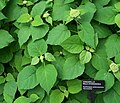Hydrangea
From Wikipedia, the free encyclopedia
| Hydrangea | ||||||||||||||
|---|---|---|---|---|---|---|---|---|---|---|---|---|---|---|
 Hydrangea macrophylla
|
||||||||||||||
| Scientific classification | ||||||||||||||
|
||||||||||||||
| Species | ||||||||||||||
|
See text |
Hydrangea (pronounced /haɪˈdreɪndʒ(i)ə/, common names Hydrangea and Hortensia) is a genus of about 70-75 species of flowering plants native to southern and eastern Asia (China, Korea, Japan, the Himalayas, and Indonesia) and North and South America. The flowers are extremely common in the Azores Islands of Portugal, particularly on Faial Island, which is known as the "blue island" due to the vast number of hydrangeas present on the island and Flores Island, Flores meaning flowers in Portuguese. By far the greatest species diversity is in eastern Asia, notably China, Korea, and Japan. Most are shrubs 1-3 m tall, but some are small trees, and others lianas reaching up to 30 m by climbing up trees. They can be either deciduous or evergreen, though the widely cultivated temperate species are all deciduous.
Species in the related genus Schizophragma, also in Hydrangeaceae, are also often known as hydrangeas. Schizophragma hydrangeoides and Hydrangea petiolaris are both commonly known as climbing hydrangeas.
Contents |
[edit] Life Cycle
Hydrangea flowers are produced from early spring to late autumn; they grow in flowerheads (corymbs or panicles) at the ends of the stems. In many species,the flowerheads contain two types of flowers, small fertile flowers in the middle of the flowerhead, and large, sterile bract-like flowers in a ring around the edge of each flowerhead. Other species have all the flowers fertile and of the same size.
[edit] Colors and Acidity
In most species the flowers are white, but in some species (notably H. macrophylla), can be blue, red, pink, light purple, or dark purple. In these species the exact colour often mirrors the pH of the soil; acidic soils produce blue flowers, neutral soils produce very pale cream petals, and alkaline soils results in pink or purple. This is the caused by a color change of the flower pigments in the presence of aluminium ions which can be taken up into hyperaccumulating plants.[1][2]
[edit] Partial list of species
- Hydrangea anomala (Climbing Hydrangea). Himalaya, southwest China.
- Hydrangea arborescens (Smooth Hydrangea). Eastern North America.
- Hydrangea aspera. China, Himalaya.
- Hydrangea bretschneideri. China.
- Hydrangea candida. China.
- Hydrangea caudatifolia. China.
- Hydrangea chinensis. China.
- Hydrangea chungii. China.
- Hydrangea cinerea (Ashy Hydrangea). Eastern United States.
- Hydrangea coacta. China.
- Hydrangea coenobialis. China.
- Hydrangea davidii. China.
- Hydrangea dumicola. China.
- Hydrangea gracilis. China.
- Hydrangea heteromalla. Himalaya, west and north China.
- Hydrangea hirta. Japan.
- Hydrangea hypoglauca. China.
- Hydrangea integrifolia. China.
- Hydrangea involucrata. Japan, Taiwan.
- Hydrangea kawakamii. Taiwan.
- Hydrangea kwangsiensis. China.
- Hydrangea kwangtungensis. China.
- Hydrangea lingii. China.
- Hydrangea linkweiensis. China.
- Hydrangea longifolia. China.
- Hydrangea longipes. Western China.
- Hydrangea macrocarpa. China.
- Hydrangea macrophylla (Bigleaf Hydrangea). Northern Venezuela, Korea, Southern Japan.
- Hydrangea mangshanensis. China.
- Hydrangea paniculata (Panicled Hydrangea). Eastern China, Korea, Japan, Sakhalin.
- Hydrangea petiolaris (Climbing Hydrangea). Japan, Korea, Sakhalin.
- Hydrangea quercifolia (Oakleaf Hydrangea). Southeast United States.
- Hydrangea radiata (Silverleaf Hydrangea). Southeast United States.
- Hydrangea robusta. China, Himalaya.
- Hydrangea sargentiana. Western China.
- Hydrangea scandens. Southern Japan south to the Philippines.
- Hydrangea serrata. Japan, Korea.
- Hydrangea serratifolia. Chile, western Argentina.
- Hydrangea stenophylla. China.
- Hydrangea strigosa. China.
- Hydrangea stylosa. China.
- Hydrangea sungpanensis. China.
- Hydrangea xanthoneura. China.
- Hydrangea zhewanensis. China.
[edit] Cultivation and uses
Hydrangeas are popular ornamental plants, grown for their large flowerheads, with Hydrangea macrophylla being by far the most widely grown with over 600 named cultivars, many selected to have only large sterile flowers in the flowerheads. Some are best pruned on an annual basis when the new leaf buds begin to appear. If not pruned regularly, the bush will become very 'leggy', growing upwards until the weight of the stems is greater than their strength, at which point the stems will sag down to the ground and possibly break. Other species only flower on 'old wood'. Thus new wood resulting from pruning will not produce flowers until the following season.
Hydrangeas are moderately toxic if eaten, with all parts of the plant containing cyanogenic glycosides.[3] In Korean tea, Hydrangea serrata (hangul:산수국 hanja:山水菊) is used for an herbal tea called sugukcha (수국차) or ilsulcha (이슬차). Hydrangea paniculata is reportedly sometimes smoked as an intoxicant, despite the danger of illness and/or death due to the cyanide.[4]
|
Hydrangea sp. painted by the botanical artist Redouté |
|||
|
8" Annabelle Hydrangia Bloom. Hydrangia arborescens. |
|||
|
Hydrangea flowers at the "Cerro El Avila" National Park, Venezuela. |
[edit] Diseases
[edit] References
1 http://www.erowid.org/herbs/hydrangea/hydrangea.shtml
[edit] External links
| Wikimedia Commons has media related to: Hydrangea |
| Wikispecies has information related to: Hydrangea |
- www.hydrangeaworld.com
- Hydrangea growing directions
- Flora of China: Hydrangea
- Flora of Nepal: Hydrangea species list
- USDA Plant Profile: Hydrangea
- Hydrangea arborescens images at bioimages.vanderbilt.edu
- Hydrangea - their pruning and care
- Hydrangea - selecting shrubs (University of Illinois Extension)
- Hydrangea Thoughts I - Informative but non-scholarly essay on Hydrangea.
- Hydrangea species and hybrids
- Endless Summer: a perpetual-flowering big-leaf Hydrangea
- "All About Hydrangeas" A website about all types of hydrangeas, planting, cultivating, drying, dying, and decorating.




















